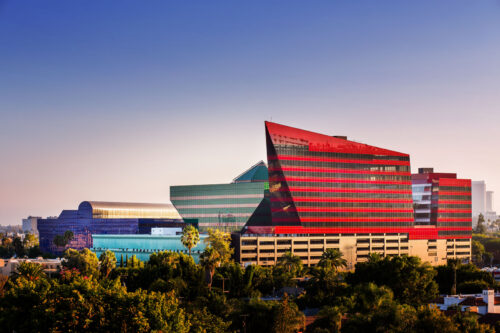Celebrating the launch of the English-language version of Chapter.digital, we’re presenting the »L.A. Special« on design-relevant aspects from and around Los Angeles. Right at the beginning, we take a look at a particularly outstanding building in the truest sense of the word.
In the heart of West Hollywood, between the legendary Santa Monica Boulevard nightlife district, prestigious Melrose Avenue and tranquil West Hollywood Park, rise the striking monolithic buildings of the Pacific Design Center (PDC). Designed in 1975 by renowned Argentine architect Cesar Pelli, the trio of postmodern glass buildings functioned for many years as the West Coast flagship of contemporary design. And even though the imposing building complex has struggled for many years with a high vacancy rate and a variety of image and acceptance problems, it is still considered an architecturally significant building with great relevance for the local design scene.
With its considerable size, which offers a total floor space of more than 14 hectares, the Pacific Design Center currently houses, in addition to countless office spaces, more than 70 design showrooms and presents more than 2,000 brands of the most diverse design directions, including the traditional British brands Farrow & Ball or George Smith, the design studio EuroConcept Kitchen, which presents quality brands such as Sub-Zero/Wolf or Miele, or the American Society of Interior Designers.

As early as 1975, the blue colossus, perceived by many as particularly disproportionate and quickly christened the »Blue Whale«, laid the ambitious foundation stone of the Pacific Design Center. With the »Green Building« in 1988 and the tapered modern office complex »Red Building« in 2012, the characteristic trio of buildings finally found its current form. The architecture of the PDC was always designed to combine minimalist aesthetics, form and function: Among other things, the primary-colored glass facades, which shine almost like gemstones in the characteristic Californian sunlight, are also intended to flood the spacious and openly designed interiors with sufficient light, create an appealing atmosphere and, in particular, also reduce energy consumption.

In any case, that use of glass, in combination with steel and concrete, still gives the complex an unmistakable industrial-minimalist touch, while in the interior, warm wood and marble elements have also been used in contrast to ensure a balanced, welcoming atmosphere. Between the three buildings, you’ll also find expansive courtyards designed as green oases lined with tall palm trees to offer peace and relaxation, and – like the myriad indoor event venues – serve as venues for a variety of cultural events.

Conceived as a hub for creativity and design, the enormous floor space and resulting occupancy problems over the years have also led to the arrival of many well-known companies outside the design industry as tenants, including outsourced laboratories of the nearby Cedars-Sinai Medical Center, the L.A. branch of international coworking space pioneer WeWork, and offices of the dating platform Grindr. The PDC also features two restaurants, a fitness center designed by renowned designer and architect Michael Graves, and expansive event spaces that have been used for high-profile film premieres, exhibitions, conferences, and even parties (including Elton John’s legendary Oscar afterparty).

The creative use of the available space for companies outside the design industry and the nevertheless constant occupancy problems are mainly due to the demand for (physical) exhibition facilities and spaces for design products, which has been drastically decreasing for many years, explains a spokesperson for the PDC. Critics from the local (design) community in West Hollywood, on the other hand, complain that the Pacific Design Center was designed to be disproportionately large for its purpose right from the start – and that it lacks harmony with the surrounding architectural identity of West Hollywood. Moreover, it no longer meets the requirements of a modern center for contemporary design – the atmosphere is more like that of an eighties shopping mall than that of a creative hub for design innovation, it is said. While it was once bustling with activity, one can currently walk through aisles of the center and not see or hear another person.

The PDC‘s exclusive by-appointment-only concept, which restricts access to interested parties, also seems a somewhat curious contrast to the open architecture, the self-proclaimed concept of the international creative hub, and the ubiquitous, literally open-minded spirit of the City of West Hollywood. Probably for this reason, the current operators of the design center have recognized that the identity and concept of the PDC must be redefined in order to meet the demands of the market on the one hand and to create a new relevance in the design scene of L.A. and beyond on the other. Courage to reflect and broaden horizons towards an inclusive, cosmopolitan center for diversity and creativity – in keeping with the original intent. [Red.]

